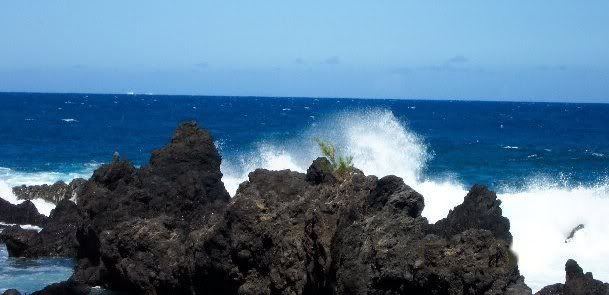April 12, 2004
Volcano Watch Week ending April 9 2004
Glowworm glows when Earth quakes
Seismometers located across the island detect earthquakes and radio the electronic signals back to HVO. The arrival of the signals at HVO might seem like the end of the story, but actually it only begins the procedure of acquiring and processing earthquake data, which is an exceptionally complicated process.
For the past five years, HVO has been running a seismic data acquisition and processing system called Earthworm. First conceived in 1993, Earthworm was developed by USGS scientists and continues to be improved upon by the USGS and many other cooperating institutions.
Recently, a suite of computer programs written primarily by scientists at the Alaska and Cascades Volcano Observatories has been installed at HVO.
These programs run in conjunction with Earthworm, creating an integrated volcano monitoring tool called Glowworm.
Glowworm systems have been installed and currently monitor active volcanoes in Mexico, El Salvador, Costa Rica, Nicaragua, Colombia, Ecuador, Montserrat, Papua New Guinea, Saipan (for the Anatahan Volcano), the Cascade Range, Alaska, and now Hawai'i. The majority of these installations were accomplished by members of the USGS working with the Volcano Disaster Assistance Program (VDAP). VDAP was formed almost 20 years ago to mitigate the risk to increasing numbers of people living on or near active volcanoes, mainly in developing countries.
The power of Glowworm lies in its extensive use of graphical user interfaces (GUI), enabling many tasks to be monitored at once. In many VDAP crisis responses, only one Glowworm computer has been needed to acquire, process, and archive data from a small network of seismic stations. The GUI provides displays for monitoring the computer system and program performance, allows amplitude and spectral data to be displayed in real-time, sounds alarms when significant events occur, and provides some ability to archive the data.
In addition to its seismic data applications, Glowworm systems are being used for mudflow monitoring on the slopes of Mount Rainier in the Cascades.
Plans are underway to use Glowworm to alert scientists about abnormal changes in ocean-water levels in Papua New Guinea that might indicate a local tsunami.
How does Glowworm actually help monitor Hawaii's active volcanoes? Signals from roughly 60 seismic stations on Hawaii and Maui are radioed to HVO in real time. These signals are digitized and fed to an Earthworm module that continuously calculates RSAM, or Real-time Seismic Amplitude Measurement, for each station. RSAM is the calculated average amplitude of the ground motion over a given time interval. The higher the RSAM, the stronger the ground motion. During a volcanic crisis, RSAM data processed in Glowworm can instantly display changes in volcanic tremor and frequency of earthquakes.
Volcanic tremor often lasts a relatively long time but has low amplitude, so RSAM is calculated over a 10-minute window for tremor detection. To detect earthquakes, a second RSAM is calculated over a 2.56-second window and is tuned to see larger average amplitudes. An alarm is declared if pre-assigned thresholds for amplitude and duration are exceeded; these thresholds differ for each station. If the conditions are met for enough stations, an alarm is automatically declared, and e-mail and pager notification is sent to those required to respond.
Glowworm can also display SSAM data (Spectral Seismic Amplitude Measurement), which measures the distribution of seismic energy being produced over a broad frequency spectrum. This can be useful in determining the type of process that is causing a specific seismic event. SSAM also provides data that will be particularly useful in future research.
Glowworm is now operational and monitoring the Kilauea summit network.
Additional tuning and implementation are required to optimize the Glowworm software to meet HVO's specific needs. We will accomplish this in the coming months.
Hawaii's volcanoes are arguably the most active in the world, with a growing number of people living in their presence. New monitoring tools, such as Glowworm, bolster our monitoring capability and provide opportunities to better understand these active volcanoes.
Activity update
Eruptive activity at Pu'u 'O'o continues. Most lava flows have been at the lower end of the rootless shield complex along the Mother's Day lava tube south of Pu'u 'O'o. Such flows have been small and short-lived but are gradually advancing toward the top of Pulama pali. Vents within the crater of Pu'u 'O'o are incandescent and sometimes visible from Mountain View and Glenwood. No lava is visible from the Chain of Craters Road.
An earthquake of magnitude 3.3 was felt in Glenwood, Hilo, and Papa'ikou at 6:51 p.m. April 1. It was located 6 km (4 miles) south-southwest of Pu'u 'O'o at a depth of 9 km (6 miles). That was the only earthquake reported felt in the week ending on April 7.
Mauna Loa is not erupting. The summit region continues to inflate slowly.
Seismic activity remains very low, with 2 earthquakes located in the summit area during the past week.
Visit our Web site (hvo.wr.usgs.gov) for daily volcano updates and nearly real-time earthquake information.
This article was written by scientists at the U.S. Geological Survey's Hawaiian Volcano Observatory.
